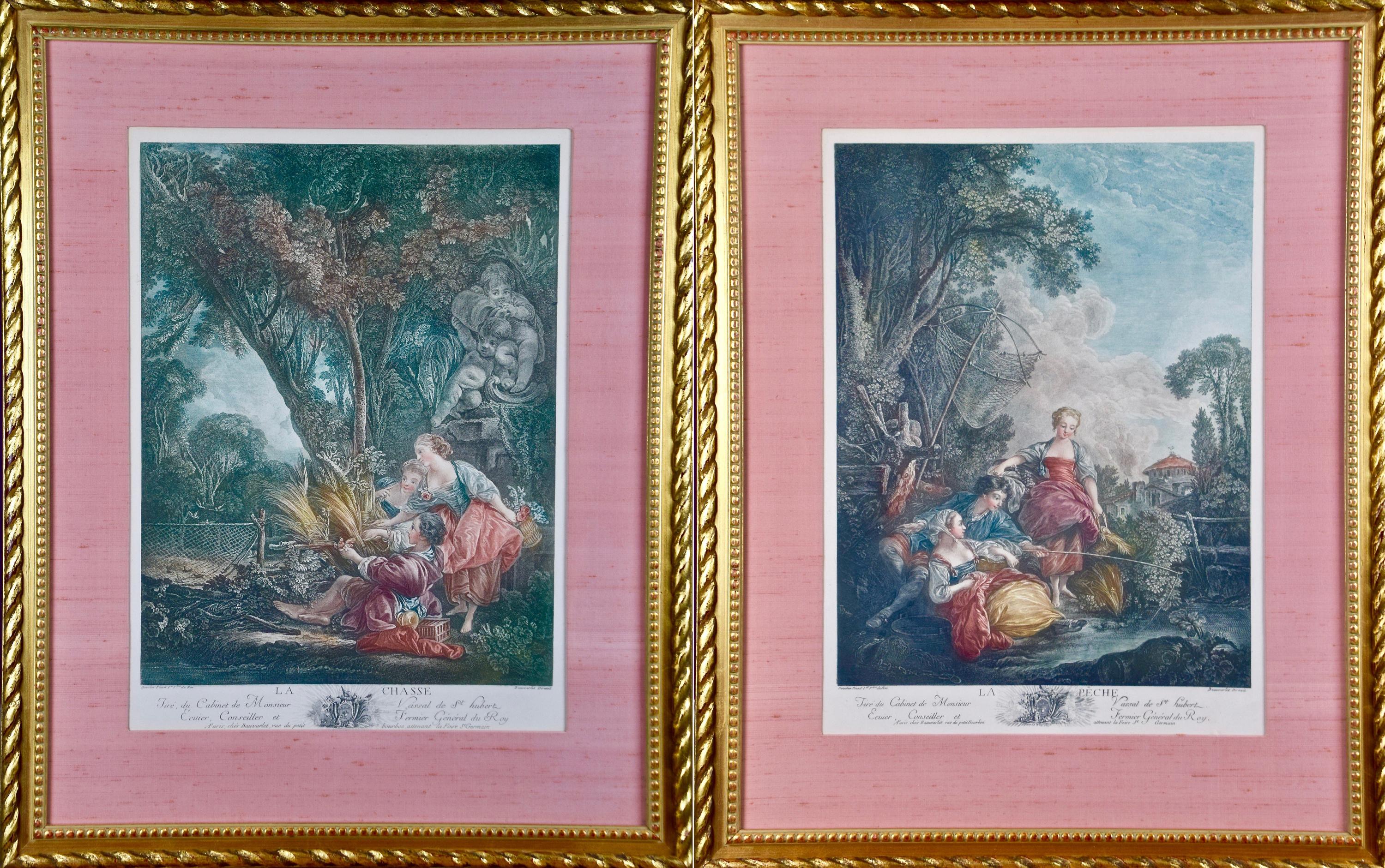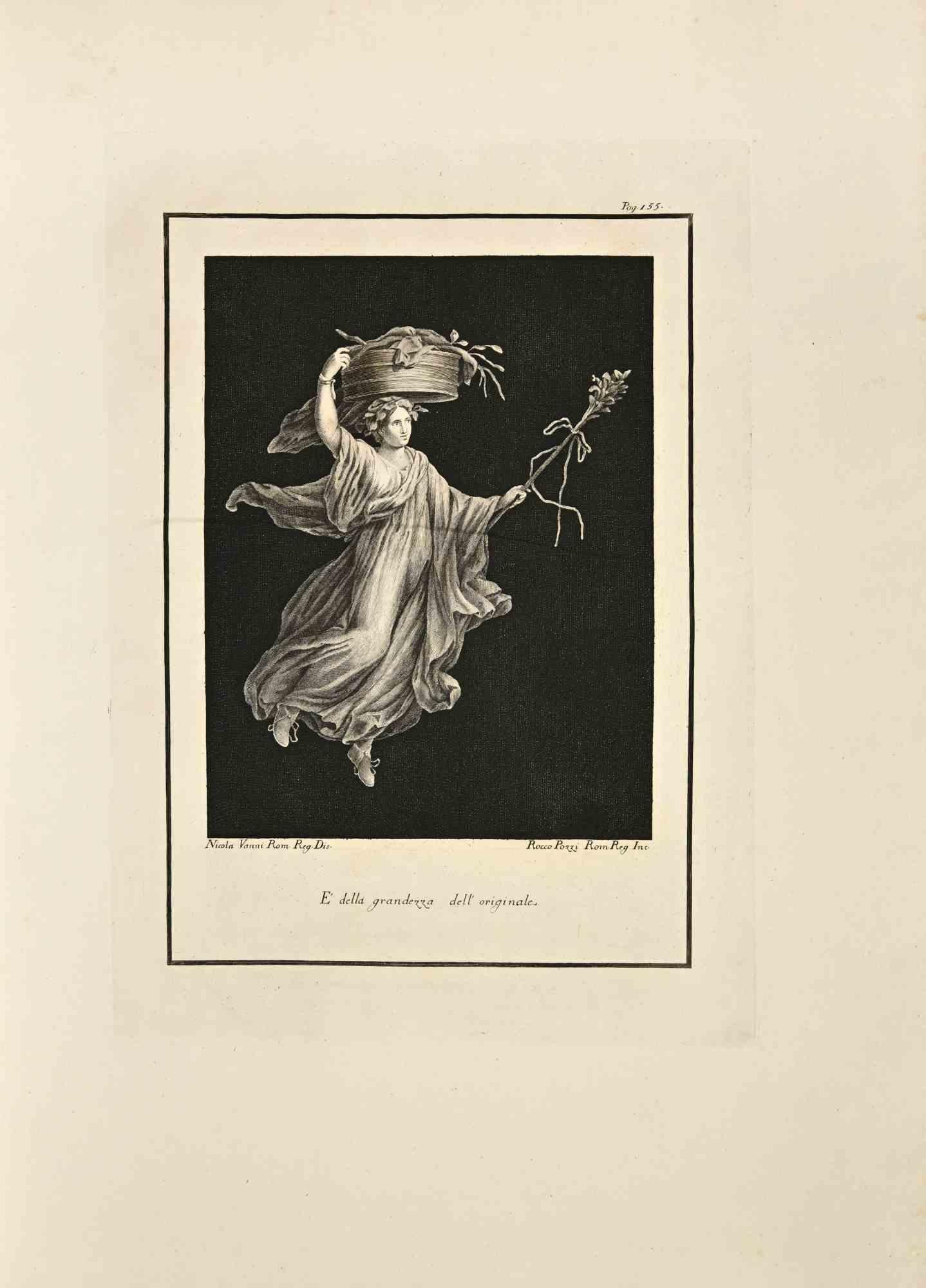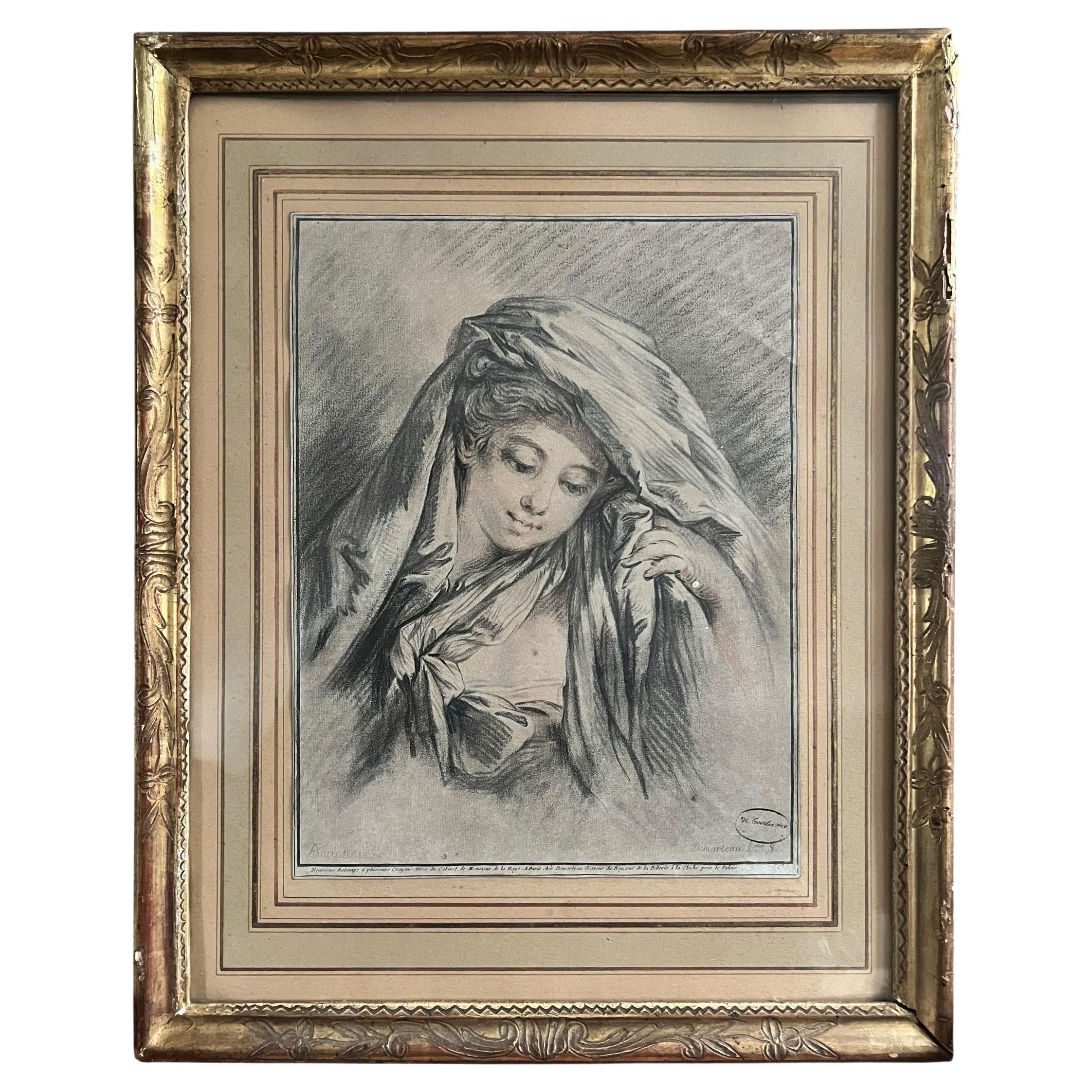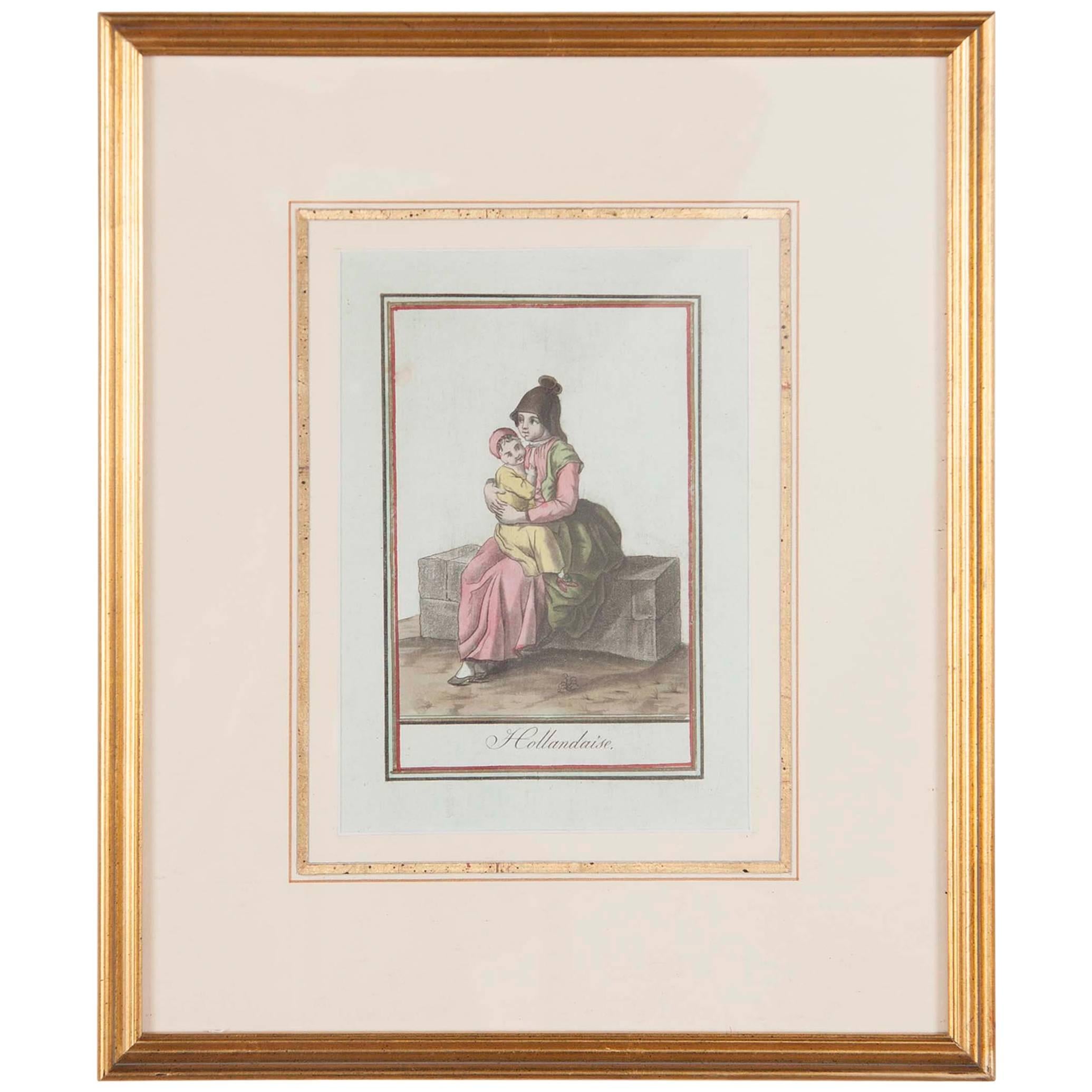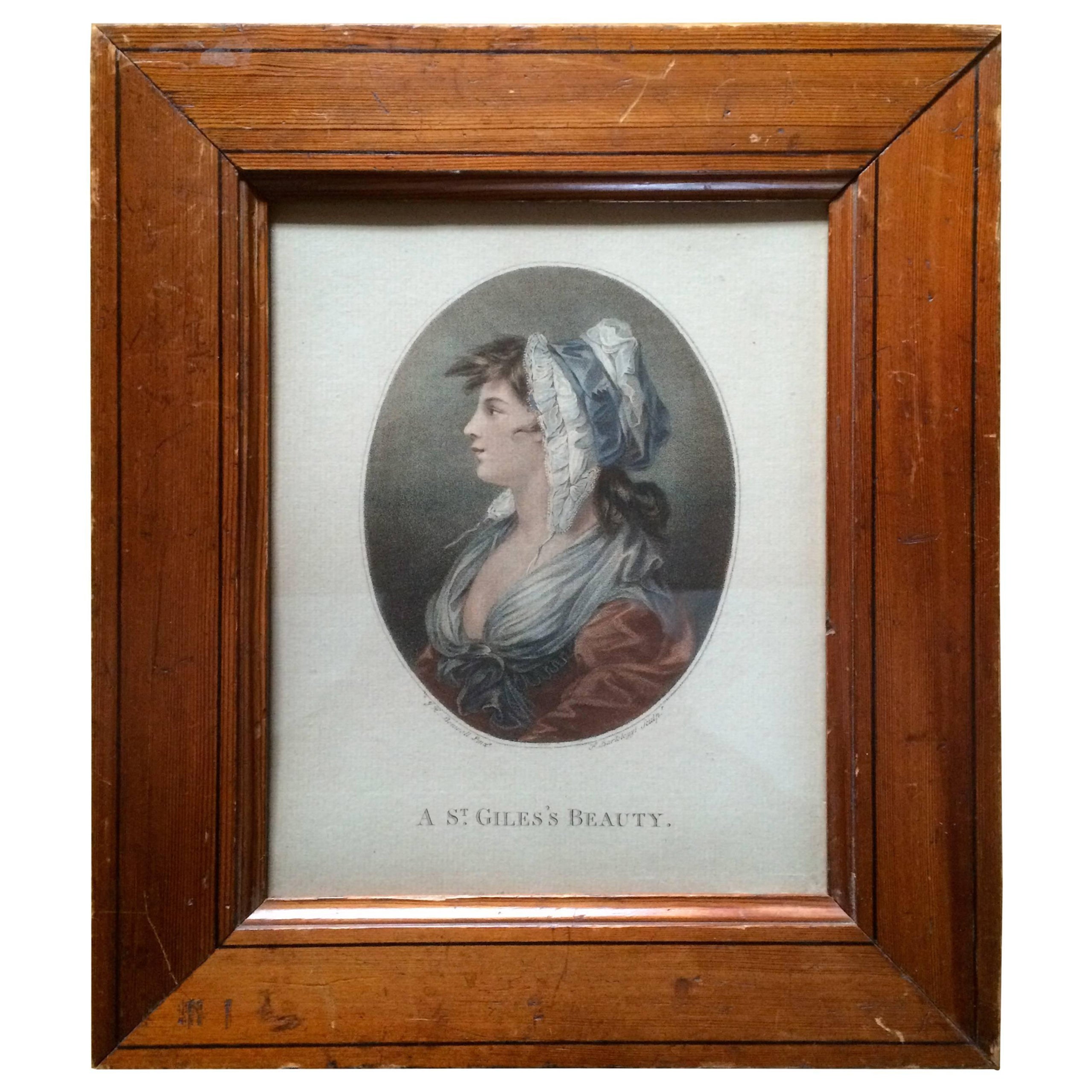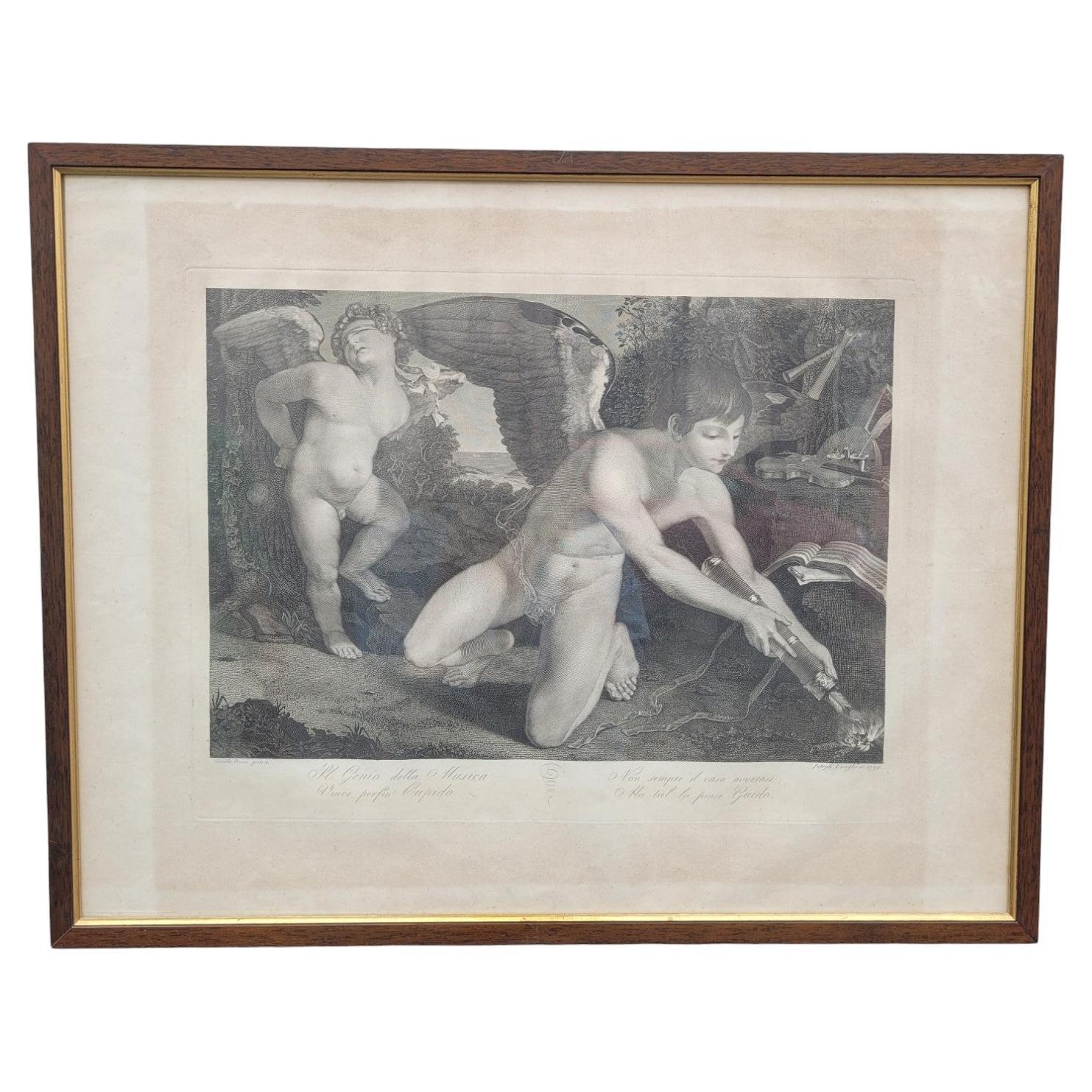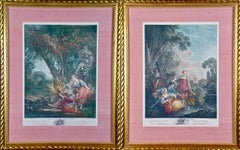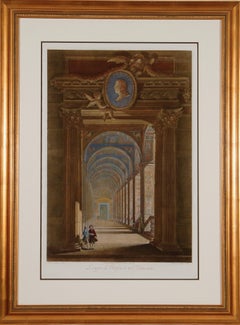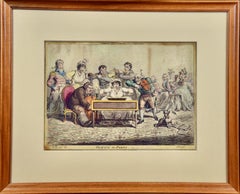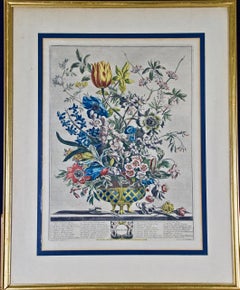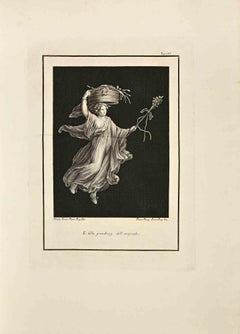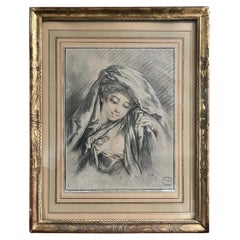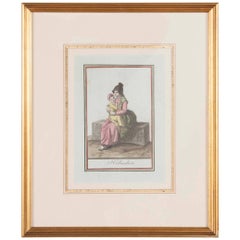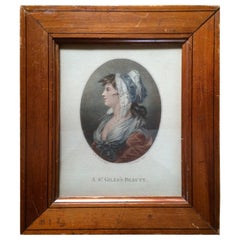Items Similar to Muse Terpsichore: Framed Hand-colored 19th C. Engraving after 17th C. Painting
Want more images or videos?
Request additional images or videos from the seller
1 of 10
After Eustache Le SueurMuse Terpsichore: Framed Hand-colored 19th C. Engraving after 17th C. Painting1803
1803
$540
$67520% Off
£416.76
£520.9520% Off
€474.46
€593.0720% Off
CA$771.07
CA$963.8420% Off
A$841.01
A$1,051.2620% Off
CHF 443.14
CHF 553.9220% Off
MX$10,085.91
MX$12,607.3820% Off
NOK 5,579.68
NOK 6,974.6020% Off
SEK 5,205.73
SEK 6,507.1620% Off
DKK 3,543.38
DKK 4,429.2220% Off
About the Item
"Dessine par Gallier" is a hand-colored engraving and etching by Pierre Laurent (1739-1809) and Pierre Audouin (1768-1822) after a painting by Eustache Le Sueur (1617-1655) in the 17th century. It is plate III from the set of three Muses, published in "Musée français" in Paris in 1803. It depicts the muse Terpsichore, thought to represent Calliope, seated striking a triangular musical instrument. It is held in the collection of The British Museum.
This hand-colored engraving is presented in an ornate antiqued gold-colored wood frame with a beaded inner trim and raised scroll work in the corners and the center of the upper, lower and both side moldings and a beige mat. There is loss of a small area of frame scroll work in the right lower corner and minimal discoloration in the upper margin, but the frame and print are otherwise in excellent condition. The frame measures 23.25" x 18.5" x 1.63".
- Creator:After Eustache Le Sueur (1617 - 1655)
- Creation Year:1803
- Dimensions:Height: 23.25 in (59.06 cm)Width: 18.5 in (46.99 cm)Depth: 1.63 in (4.15 cm)
- Medium:
- Movement & Style:
- Period:
- Condition:
- Gallery Location:Alamo, CA
- Reference Number:Seller: 43651stDibs: LU117326352212
About the Seller
5.0
Platinum Seller
Premium sellers with a 4.7+ rating and 24-hour response times
Established in 2011
1stDibs seller since 2019
298 sales on 1stDibs
Typical response time: 1 hour
- ShippingRetrieving quote...Shipping from: Alamo, CA
- Return Policy
More From This Seller
View AllPair of Hand-colored Romantic French Engravings after Francois Boucher
By (After) Francois Boucher
Located in Alamo, CA
A pair of French classical romantic prints original created in the 18th century by Jacques-Firmin Beauvarlet (1731-1797) after paintings by Francois Boucher (1703-1770), utilizing ...
Category
18th Century Romantic Figurative Prints
Materials
Engraving, Etching
Vatican Hallway designed by Raphael: 18th C. Hand-colored Engraving by Volpato
By Giovanni Volpato
Located in Alamo, CA
This is an original 18th century hand-colored copper-plate engraving by Giovanni Volpato after a drawing by Camporesi. It was the frontispiece for volume one of the rare and valuable...
Category
Late 18th Century Old Masters Interior Prints
Materials
Engraving
"Playing in Parts": A 19th Century James Gillray Hand-colored Musical Caricature
By James Gillray
Located in Alamo, CA
This hand-colored etching and aquatint caricature entitled "Playing in Parts" by James Gillray was published in London by Hanna Humphrey, 27 St. James Street on May 15th 1801. The print is signed in the plate in the lower right. This is a rare musical caricature. It depicts five amateur musicians, a woman and four men, performing their music in a drawing room. A young overweight woman dressed in white is seated in the center, playing a piano...
Category
Early 19th Century Portrait Prints
Materials
Etching
"February Bouquet" from 'The Twelve Months of Flowers' series by Robert Furber
By Robert Furber
Located in Alamo, CA
This framed hand-colored engraving entitled "February Bouquet" is from 'The Twelve Months of Flowers' by Henry Furber, published in London in 1730 by Robert Sayer and John King. Each of the twelve hand-colored engravings in the book were produced from paintings by Pieter Casteels (1684-1749) and engraved by Henry Fletcher (1710-1753). The book featured twelve detailed engravings of seasonal plants in bloom in the form of a bouquet. More than 400 different species of flowering plants were included with each plant numbered and accompanied by a list of the corresponding species names. Thirty-five species of flowers are depicted in this engraving in a bouquet sitting in an ornate attractive bowl. A few of the flowers lie loose on a table. The flower species are listed in a table in the lower portion of the plate, along with the month that these flowers are in bloom.
This colorful print is presented in a gold-colored wood frame with a cream-colored double mat with a heather green inner mat. The frame measures 23.5" High, 19" wide and 1.63" deep. There are a few small frame abrasions, but the print is in very good condition.
Robert Furber...
Category
Mid-18th Century Naturalistic Still-life Prints
Materials
Engraving
Tillotson, Archbishop of Canterbury: An 18th C. Hand-Colored Portrait by Kneller
By (After) Sir Godfrey Kneller
Located in Alamo, CA
This is a hand-colored portrait of John Tillotson, Archbishop of Canterbury, engraved and etched by the Dutch master of portraits Jacobus Houb...
Category
Mid-18th Century Naturalistic Portrait Prints
Materials
Engraving, Etching
Parmigiani Amica: An 18th Century Engraving and Etching by Strange After Mazzola
Located in Alamo, CA
This is an 18th century engraving and etching entitled "Parmigiani Amica" by Robert Strange after a painting by Girolamo Francesco Maria Mazzola, better known as Parmigianino, who lived during the Renaissance period. It was published in London in 1774. As the inscription states, the painting was in the collection of the King of Naples at the time the engraving was made. The engraving depicts a half-length portrait of a young woman, known as Parmigiani's Amica (meaning "female friend" in Italian). She is depicted wearing a simple but elegant dress with a low-cut neckline, which reveals her delicate features and graceful neck. Her hair is arranged in a simple yet stylish manner. She is turning to the right to look lovingly at her infant, which she is holding with her right arm. She is touching the baby's mouth with her left hand. The background of the engraving is plain and unadorned, allowing the viewer to focus entirely on the subject of the portrait. The result is a beautiful and timeless image that captures the essence of Renaissance portraiture.
The engraving is printed on watermarked paper. The sheet measures 16.25" high and 12' wide. The sheet is adhered to paper in its upper corners and it has been removed from the paper in its lower corners. There is some mild discoloration and some wrinkling in the margins, including the lower inscription area, and a small dark spot in the upper margin, which may represent a drop of ink occuring at the time of printing. These issues do not involve the image, which is in very good condition. The print is held by several museums and institutions, including: The Metropolitan Museum of Art in New York, The British Museum in London, The Royal Museums of the UK, The British National Trust...
Category
Late 18th Century Portrait Prints
Materials
Engraving, Etching
$1,500 Sale Price
20% Off
You May Also Like
A Bacchante Carrying A Large Basket - Etching by Roccus Pozzi - 18th Century
By Roccus Pozzi
Located in Roma, IT
A Bacchante Carrying A Large Basket from "Antiquities of Herculaneum" is an etching on paper realized by Roccus Pozzi in the 18th Century.
Signed on the plate.
Good conditions and ...
Category
Late 18th Century Old Masters Figurative Prints
Materials
Etching
Engraving after François Boucher – Young Woman with a Covered Head- 18th century
By François Boucher
Located in Beuzevillette, FR
Superb antique engraving by Jean-Charles François Demarteau (1730–1808), the renowned Graveur du Roi (Engraver to the King), after a drawing by François Boucher, one of the greatest ...
Category
Antique 18th Century French Rococo Prints
Materials
Paper
18th Century French Hand Colored Engraving of a Dutch Mother and Child
By Jacques Grasset de Saint-Sauveur
Located in Stamford, CT
From: 'Costumes of Various Countries' by Jacques Grasset de Saint-Sauveur, circa 1797. Hand colored engravings on paper. 'Hollandie', showing a mother and child in native costume fro...
Category
Antique Late 18th Century French Neoclassical Prints
18th Century Portrait Color Engraving, Original Frame, 'A Saint Giles's Beauty'
By Francesco Bartolozzi
Located in Stamford, CT
Stipple and etching, printed in dark brown ink with hand-coloring. Likely the original late 18th century frame and thus the print is in excellent condition.
Print made by Francesco Bartolozzi...
Category
Antique Late 18th Century English Neoclassical Prints
Materials
Paper
G Longhi, Il Genio De La Musica - Cupido, Framed Engraving, 19th Century
By Guido Reni
Located in MARSEILLE, FR
"il genio de la musica vince per fin Cupido" / the Genius of Music triumphant over Love, based on a 17th century work by Guido Reni, kept at the Palazzo Spinola in Genoa.
This frame...
Category
Antique 19th Century Italian Empire Prints
Materials
Paper
G Longhi, Il Genio De La Musica - Cupido, Framed Engraving, 19th Century
By Guido Reni
Located in MARSEILLE, FR
"il genio de la musica vince per fin Cupido" / the Genius of Music triumphant over Love, based on a 17th century work by Guido Reni, kept at the Palazzo Spinola in Genoa.
This frame...
Category
Antique 19th Century Italian Empire Prints
Materials
Paper
More Ways To Browse
Framed Scrolls
Ornate Wood Frames
19th Hand Colored Engraving
19th Century Colored Engraving
19th Century Engraving Framed
Picasso Imaginaire 1969
Picasso Knight
Picasso Lithograph Maternity
Picasso Sable Mouvant
Picasso Salome
Picasso Signed Bull
Pig And Pepper
Piranesi Appia
Prescott Chaplin
Raphael Et La Fornarina
Ray Euffa
Rc Gorman Print
Reiss Studio
